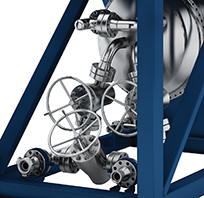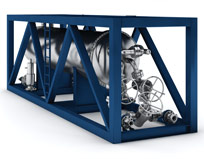Heat Exchanger (Standard Type)
Features
- Internal tubing coil for effluent flow inside pressurised steam outer shell
- Automatic temperature control
- Choke between inlet and outlet to allow preheating of effluent
- Bypass manifold to avoid erosion in coils during well clean-up
- Steam trap with steam condensate outlet
- Glass-wool insulation on outer shell with aluminium jacket
- Spares toolbox mounted in skid
Benefits
- Improved separation efficiency through viscosity reduction and breaking emulsions
- Avoiding flow restriction from gas hydrate formation
- Enabling well test operations where indirect-fired heaters are not permitted
The Heat Exchanger Standard is a skid-mounted steam vessel which contains a high pressure coil and choke through which the well stream can be diverted upstream of the separator.
A separate steam generator supplies a constant flow of steam in contact with the coil to raise the temperature of the well effluent to prevent hydrate formation from plugging or restricting the flow and to improve separation and burner efficiency by reducing fluid viscosity and breaking down emulsions.
Hunting provides a customised design, taking account of thermal design features, high/low pressure limits, temperature range, product mix and fluid flow capacity. Hunting’s manufacturing flexibility enables them to supply heat exchangers for a variety of volume requirements.
The temperature of the well effluent downstream of the heat exchanger is monitored through a control-valve which then varies the steam flow into the vessel to maintain a pre-set temperature.




